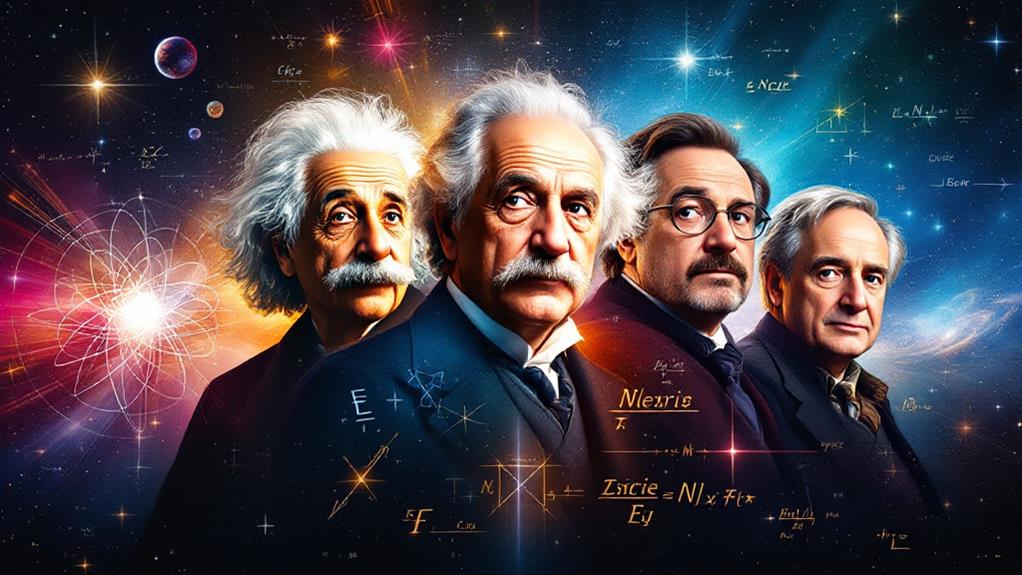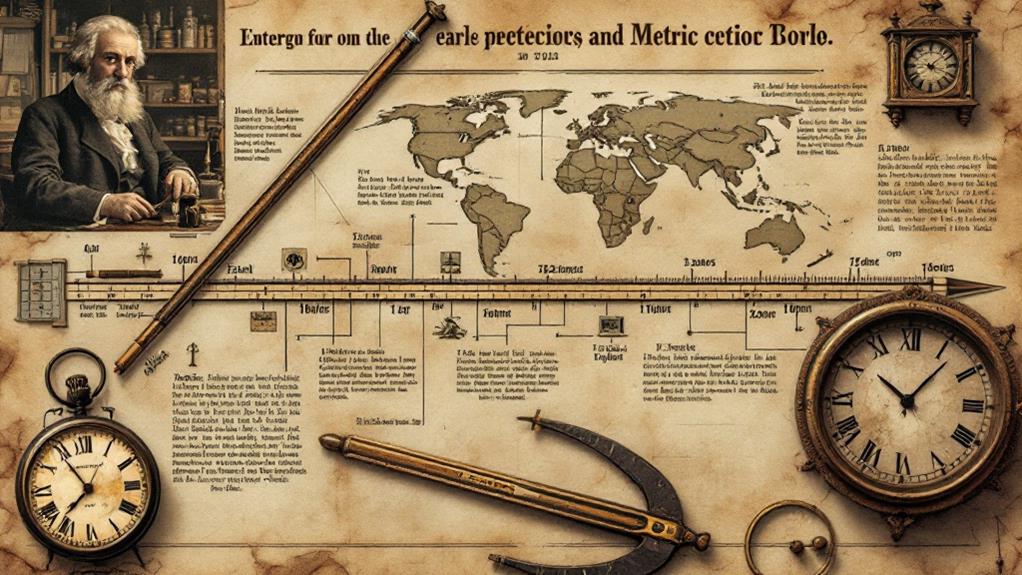Famous Physicists and Their Discoveries: Contributions That Changed the World

Six physicists have fundamentally changed our understanding of the universe. Isaac Newton's laws of motion explained planetary orbits and terrestrial mechanics. Albert Einstein's relativity theories revolutionized concepts of space, time, and gravity. Marie Curie's radioactivity research paved the way for nuclear physics. Niels Bohr's atomic model laid the foundation for quantum mechanics. Stephen Hawking's black hole theories challenged our notions of spacetime. Richard Feynman's quantum electrodynamics unified different viewpoints on quantum theory. These brilliant minds have shaped modern physics and technology, from GPS to medical treatments. Their pioneering explorations continue to inspire new generations of scientists to expand the frontiers of knowledge.
Isaac Newton's Laws of Motion
Although many scientists contributed to our understanding of motion, Isaac Newton's laws revolutionized physics. You've likely heard of his three laws of motion, which form the foundation of classical mechanics. The first law states that an object at rest stays at rest, and an object in motion stays in motion unless acted upon by an external force. The second law explains that force equals mass times acceleration, while the third law declares that for every action, there's an equal and opposite reaction.
Newton's laws of universal gravitation further expanded our perception of motion, explaining the force that attracts objects with mass towards each other. This theory not only explained planetary motion but also tied together the concepts of celestial and terrestrial mechanics.
Beyond motion, Newton made significant contributions to optics with his corpuscular theory of light. He proposed that light consisted of tiny particles, which explained phenomena like reflection and refraction. Although later discoveries showed light's wave-like properties, Newton's work laid the groundwork for future research in optics and quantum mechanics.
Newton's laws continue to be fundamental in physics, engineering, and our everyday understanding of the world around us.
Albert Einstein's Relativity Theories
Einstein's theories of relativity turned the physics world upside down in the early 20th century. His paradigm-shifting work revolutionized our understanding of space, time, and gravity.
In 1905, Einstein introduced his special theory of relativity. It proposed that the speed of light is constant for all observers, regardless of their motion. This led to the famous equation E=mc², which relates energy and mass. The theory also introduced the concept of spacetime, where space and time are interconnected.
A decade later, Einstein presented his general theory of relativity. This expanded on special relativity by incorporating gravity. He described gravity not as a force, but as a curvature of spacetime caused by massive objects. This theory explained phenomena like the bending of light around massive bodies and the precession of Mercury's orbit.
Einstein's theories have been extensively tested and confirmed. They're indispensable for technologies you use daily, like GPS systems. They've also led to predictions of exotic cosmic phenomena, such as black holes and gravitational waves. Einstein's work continues to shape our understanding of the universe and inspire new generations of physicists.
Marie Curie's Radioactivity Research

In light of Einstein's pioneering theories, Marie Curie's work on radioactivity stands as another monumental achievement in physics. You'll find that Curie's research revolutionized our understanding of atomic structure and laid the foundation for nuclear physics.
Curie's expedition began with her investigation of uranium rays, which led her to discover two new radioactive elements: polonium and radium. She meticulously studied the properties of these radioactive materials, uncovering their unique characteristics and behavior. Through her experiments, Curie demonstrated that radioactivity was an atomic property, not influenced by chemical or physical state.
You'll be amazed to learn that Curie developed methods to isolate radioactive isotopes and measure their activity. Her work on radioactivity properties paved the way for numerous applications in medicine and industry. Curie's research also shed light on the dangers of radiation exposure, leading to essential safety protocols.
Her groundbreaking discoveries earned her two Nobel Prizes, making her the first person to achieve this feat. Curie's legacy continues to inspire scientists worldwide, and her contributions remain fundamental to our understanding of radioactivity and nuclear physics.
Niels Bohr's Atomic Model
Building upon the groundwork laid by earlier atomic theories, Niels Bohr revolutionized our understanding of atomic structure with his pioneering model in 1913. His model proposed that electrons orbit the nucleus in fixed energy levels, and they can jump between these levels by absorbing or emitting specific amounts of energy.
Bohr's atomic model explained the observed spectral lines of hydrogen and provided a structure for understanding the behavior of electrons in atoms. It introduced the concept of quantized energy levels, which laid the foundation for quantum mechanics. You'll find that Bohr's model also incorporated his complementarity principle, which states that particles can exhibit both wave-like and particle-like properties, but not simultaneously.
Additionally, Bohr's correspondence principle bridged the gap between classical and quantum physics. It suggests that quantum mechanics must agree with classical physics in the limit of large quantum numbers. This principle helped reconcile the seemingly contradictory nature of these two fundamental theories. Bohr's work not only advanced our understanding of atomic structure but also paved the way for further developments in quantum mechanics and modern physics.
Stephen Hawking's Black Hole Theories

Stephen Hawking burst onto the physics scene with his pioneering work on black holes, revolutionizing our understanding of these cosmic enigmas. His groundbreaking theories challenged existing notions and pushed the boundaries of our knowledge about the universe.
You'll find Hawking's most significant contributions in his work on the black hole singularity. He proved that singularities aren't just mathematical oddities but real phenomena predicted by Einstein's general relativity. This discovery led to the realization that the universe itself likely began from a singularity in the Big Bang.
Hawking's research also tackled the black hole information paradox, a problem that arises when you consider what happens to information that falls into a black hole. He proposed that black holes might not be entirely "black" after all, suggesting they emit radiation, now known as Hawking radiation. This concept implies that black holes can slowly evaporate over time, potentially resolving the paradox.
Through his work, Hawking bridged the gap between quantum mechanics and general relativity, two fundamental yet seemingly incompatible theories. His ideas continue to inspire physicists worldwide, driving ongoing research into the nature of black holes and the fabric of spacetime.
Richard Feynman's Quantum Electrodynamics
Richard Feynman's name is synonymous with quantum electrodynamics (QED), a theory that revolutionized our understanding of how light and matter interact. His work in this field earned him the Nobel Prize in Physics in 1965, alongside Julian Schwinger and Sin-Itiro Tomonaga.
Feynman's approach to QED was pioneering. He developed a way to visualize complex particle interactions using simple diagrams, now known as Feynman diagrams. These diagrams became an essential tool in quantum field theory, allowing physicists to calculate probabilities of various particle interactions quickly and accurately.
You'll find Feynman's contributions extend beyond just theory. He invented a mathematical method called path integrals, which provided a new way to formulate quantum mechanics. This approach helped unify different viewpoints on quantum theory and proved crucial in later developments in particle physics.
Feynman's work on QED didn't just explain existing phenomena; it predicted new ones. His calculations of the magnetic moment of the electron matched experimental results with unparalleled accuracy, cementing QED's status as one of the most precise theories in physics. Today, QED remains a cornerstone of modern physics, influencing fields from particle physics to quantum computing.



